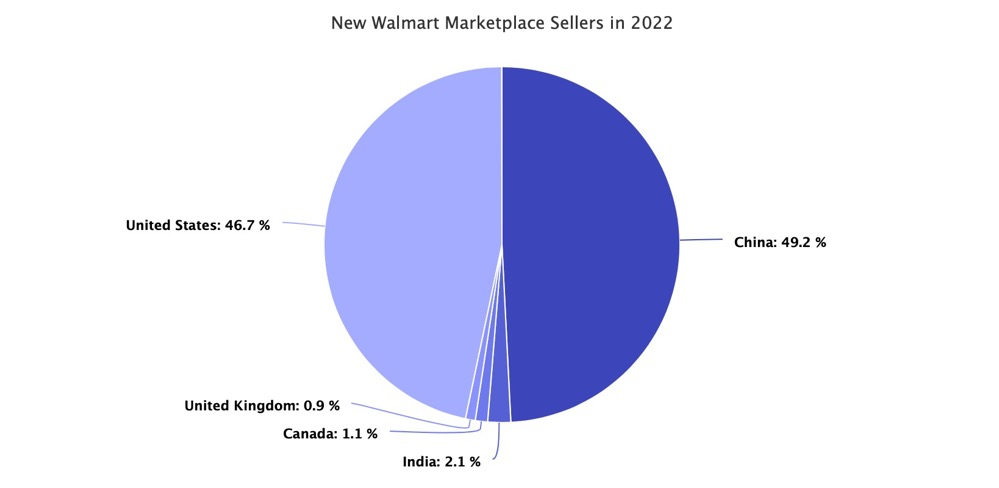YCD news, according to a new MarketplacePulse study, the number of foreign sellers from China, India, Canada and the United Kingdom exceeded the number of its U.S.-based sellers in Walmart’s third-party seller base over the past year, with Chinese sellers being the most active.
The study shows that 46.7 percent of Walmart’s new third-party sellers in 2022 will be from the U.S. mainland, with the rest being foreign sellers, and most of them will be Chinese. Until 2023, Walmart’s foreign new seller growth has been outpacing that of the U.S., and so far, U.S. sellers still account for a minority of Walmart’s new seller percentage.
YCD has learned that Walmart’s e-commerce business has undergone two major transformations in the past decade.
The first was in 2016, when Jet.com acquired Walmart, and Walmart’s e-commerce business started its acquisition-based expansion path, acquiring brands such as Moosejaw and Bonobos and Flipkart, India’s largest online retailer, since when Walmart’s e-commerce business has really started to grow.
The second time was in March 2021, when Walmart’s third-party marketplace was first opened to non-U.S. sellers. Prior to that, Walmart Third Party Marketplace was only available to U.S. sellers invited to join.
On March 25, 2021, Walmart’s U.S. site investment strategy launch was held in Nanshan, Shenzhen, officially recruiting Chinese third-party sellers to join. Walmart then began recruiting sellers in India in January 2022, the United Kingdom in June 2022 and Canada in August 2022.

To date, China accounts for more than 90% of Walmart’s new international sellers and nearly half of all new sellers. Although Walmart may subsequently add more countries beyond India, the United Kingdom and Canada, Chinese sellers will still dominate, which is determined by the current competitive landscape Walmart faces in the U.S. e-commerce market.
In recent years, Amazon has relied on its strong e-commerce business to climb its share of the U.S. retail market, posing a threat to Walmart’s position as a retail giant.
In 2021, Amazon’s share of the U.S. e-commerce market hit a record high of 56.7%, directly leading to its retail market share growing to 9.4%, surpassing Walmart’s 8.65%. This means that for the first time, Amazon, which was founded 28 years ago, surpassed Walmart, which was founded 60 years ago, to become the largest retailer in the United States.
On the other hand, Temu and Shein are rising in the U.S. e-commerce market to further divide the market share, and various crises have driven Wal-Mart to accelerate the pace of e-commerce business expansion.
It is worth noting that whether it is Amazon, the old rival, or Temu, Shein, the new rival, its supply chain is mainly dependent on Chinese sellers to build. In Amazon, the share and GMV of Chinese sellers are on the rise.
As a result, Walmart has also accelerated the recruitment of Chinese sellers. In August last year, Walmart relaxed the entry threshold for foreign sellers, simplified the entry process and shortened the entry timeline for WMC (Walmart Advertising) as well as WFS. In February this year, Walmart even completely removed the annual GMV investment threshold restrictions for Chinese sellers.
As competition with Amazon becomes increasingly fierce, Walmart is expected to continue to make Chinese sellers a key recruiting target in order to seize the advantage in the supply chain.
